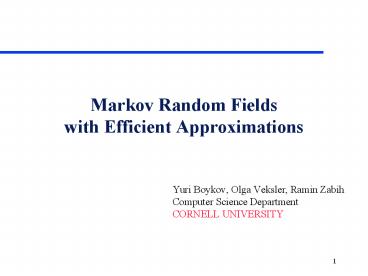Markov Random Fields with Efficient Approximations - PowerPoint PPT Presentation
1 / 30
Title:
Markov Random Fields with Efficient Approximations
Description:
MRF framework in the context of stereo. MRF defining property: Hammersley-Clifford Theorem: ... Stereo Image: White Rectangle in front of. the black background ... – PowerPoint PPT presentation
Number of Views:119
Avg rating:3.0/5.0
Title: Markov Random Fields with Efficient Approximations
1
Markov Random Fields with Efficient
Approximations
- Yuri Boykov, Olga Veksler, Ramin Zabih
- Computer Science Department
- CORNELL UNIVERSITY
2
Introduction
- MAP-MRF approach
- (Maximum Aposteriori Probability estimation of
MRF) - Bayesian framework suitable for problems in
Computer Vision (Geman and Geman, 1984) - Problem High computational cost. Standard
methods (simulated annealing) are very slow.
3
Outline of the talk
- Models where MAP-MRF estimation is equivalent to
min-cut problem on a graph - generalized Potts model
- linear clique potential model
- Efficient methods for solving the corresponding
graph problems - Experimental results
- stereo, image restoration
4
MRF framework in the context of stereo
- image pixels (vertices)
- neighborhood relationships (n-links)
MRF defining property
Hammersley-Clifford Theorem
5
MAP estimation of MRF configuration
6
Energy minimization
7
Generalized Potts model
8
Static clues - selecting
Stereo Image White Rectangle in front of
the black background
9
Minimization of E(f) via graph cuts
p-vertices (pixels)
10
Multiway cut
vertices V pixels terminals
Remove a subset of edges C
edges E n-links t-links
- C is a multiway cut if terminals are separated
in G(C)
11
Main Result (generalized Potts model)
- Under some technical conditions on
the multiway min-cut C on G gives___
that minimizes E( f ) - the posterior energy
function for the generalized Potts model.
- Multiway cut Problem find minimum cost
multiway cut C graph G
12
Solving multiway cut problem
- Case of two terminals
- max-flow algorithm (Ford, Fulkerson 1964)
- polinomial time (almost linear in practice).
- NP-complete if the number of labels gt2
- (Dahlhaus et al., 1992)
- Efficient approximation algorithms that are
optimal within a factor of 2
13
Our algorithm
Initialize at arbitrary multiway cut C
1. Choose a pair of terminals
2. Consider connected pixels
14
Our algorithm
Initialize at arbitrary multiway cut C
1. Choose a pair of terminals
2. Consider connected pixels
3. Reallocate pixels between two terminals
by running max-flow algorithm
15
Our algorithm
Initialize at arbitrary multiway cut C
1. Choose a pair of terminals
2. Consider connected pixels
3. Reallocate pixels between two terminals
by running max-flow algorithm
4. New multiway cut C is obtained
Iterate until no pair of terminals improves the
cost of the cut
16
Experimental results (generalized Potts model)
- Extensive benchmarking on synthetic images and on
real imagery with dense ground truth - From University of Tsukuba
- Comparisons with other algorithms
17
Synthetic example
Image
18
Real imagery with ground truth
Ground truth
Our results
19
Comparison with ground truth
20
Gross errors (gt 1 disparity)
21
Comparative results normalized correlation
Data
Gross errors
22
Statistics
23
Related work (generalized Potts model)
- Greig et al., 1986 is a special case of our
method (two labels) - Two solutions with sensor noise (function g)
highly restricted - Ferrari et al., 1995, 1997
24
Linear clique potential model
25
Minimization of via graph cuts
26
Main Result (linear clique potential model)
- Under some technical conditions on
the min-cut C on gives that
minimizes - the posterior energy
function for the linear clique potential model.
27
Related work (linear clique potential model)
- Ishikawa and Geiger, 1998
- earlier independently obtained a very similar
result on a directed graph - Roy and Cox, 1998
- undirected graph with the same structure
- no optimality properties since edge weights are
not theoretically justified
28
Experimental results (linear clique potential
model)
- Benchmarking on real imagery with dense ground
truth - From University of Tsukuba
- Image restoration of synthetic data
29
Ground truth stereo image
30
Image restoration































